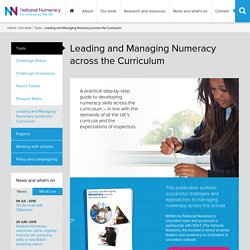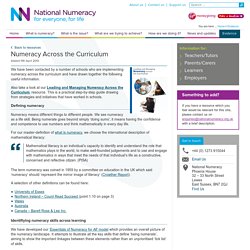

Leading and Managing Numeracy across the Curriculum. The booklet outlines successful strategies and approaches to managing numeracy across the school.

It takes account of the varied nature of secondary schools and offers strategies for ensuring participation from the whole school community – from the senior management team to parents and carers. Strengthening numeracy across the curriculum will develop students’ numeracy confidence and proficiency as well as their appreciation of the wider use and application of mathematics. This will help to raise attainment levels in maths, science and other subjects. Topics include: ProfessionalLearningMatri.
Factsheet-4-9-n.pdf. Factsheet-l-n.pdf. Numeracyteachdomains.pdf. NumeracyLiteracyStrategy.pdf. Urrbrae Agricutural High School. Numeracy various definitions 2015. Numeracy in Canada. About numeracy Numeracy is one of several categories used to measure literacy.

Others include document literacy (the skills needed to understand information in various formats such as charts, graphs, forms and maps), and prose literacy (the knowledge and skills needed to understand and use information from texts including editorials, news stories, brochures and instruction manuals). According to Statistics Canada, numeracy (or quantitative literacy) is: "The knowledge and skills required to effectively manage the mathematical demands of diverse situations.” This includes such skills as calculating a tip at a restaurant, balancing a bank account, or determining the amount of interest on a loan from an advertisement. Numeracy is an essential part of what many people consider “basic literacy,” and as such it is instrumental to developing a more sophisticated set of literacy skills. However, as this numeracy map of Canada shows, we may not be as literate as we think.
Useful Resources for Teachers/Tutors. The Mathematical Journey. Why the idea of a ‘journey’?

Numeracy is a life skill – necessary to allow each of us to make informed choices and decisions in all aspects of everyday life. This can be at home, at work, as a consumer, as a parent. It touches activities not only such as choosing a mortgage or a utilities contract, checking invoices or wage slips, working out a monthly budget or helping with children’s homework, but also planning a journey, cooking a meal, reading a newspaper, or playing sport.
Confidence and competence in numeracy affect all aspects of our lives, every day. Numeracy is also a lifelong skill. It may help therefore to consider your own use and learning of numeracy as an ongoing and lifelong journey, with new skills, new understanding and new uses necessary at various points in life. The nature of the journey. South Australia's Strategic Plan. Explanatory Comments National Minimum Standard The proportion of South Australian students above the reading, writing and numeracy minimum standard for school years 3, 5, 7 and 9 has essentially remained static for all years.

For 2014, only year 5 numeracy is currently at the target improvement level of 5% points but like other year levels this is likely to fluctuate by 3-4% (up or down) over the next few years. Higher proficiency bands For most year levels the proportion of South Australian students in the NAPLaN higher proficiency bands, in reading, writing and numeracy fluctuated annually between 2011 (base year) and 2014: LOTUS Diagram Research.
Numeracy Across the Curriculum. Back to resources We have been contacted by a number of schools who are implementing numeracy across the curriculum and have drawn together the following useful information.

Also take a look at our Leading and Managing Numeracy Across the Curriculum resource. This is a practical step-by-step guide drawing from strategies and initiatives that have worked in schools. Defining numeracy Numeracy means different things to different people. For our master-definition of what is numeracy, we choose the international description of mathematical literacy: Mathematical literacy is an individual’s capacity to identify and understand the role that mathematics plays in the world, to make well-founded judgements and to use and engage with mathematics in ways that meet the needs of that individual’s life as a constructive, concerned and reflective citizen. A selection of other definitions can be found here: Statistical Language - Quantitative and Qualitative Data. What are quantitative and qualitative data?

Quantitative data are measures of values or counts and are expressed as numbers. Quantitative data are data about numeric variables (e.g. how many; how much; or how often). Qualitative data are measures of 'types' and may be represented by a name, symbol, or a number code. Qualitative data are data about categorical variables (e.g. what type). LOTUS Diagram Each Faculty. LOTUSDIAGRAM2015. Performance & Development Plan Blank DECD. ProfessionalLearningMatri. STELLA Professional Standards. Numeracy & Leadership TfEL. Numeracy discussion starters. Scotland Numeracy Across Curriculum. Assessment For Learning Activities. Assessment AAMT. Gratton Institute Summary. Mathematising TfEL A4. Six key principles. Gratton making time for great teaching. Some Thoughts to Guide Num. Numeracy audit book v6. AAMTSelfEvaluation07Rubric. Numeracy Literacy Strategy DECD. Numeracy Goos.